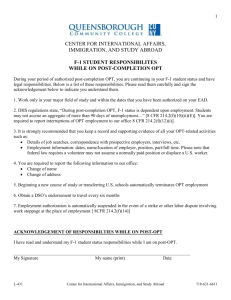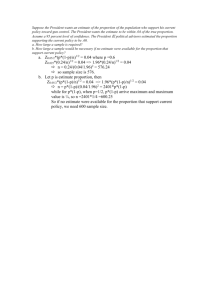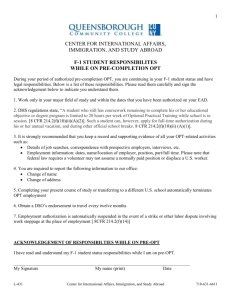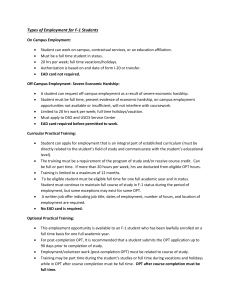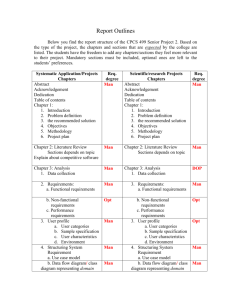Presented
advertisement
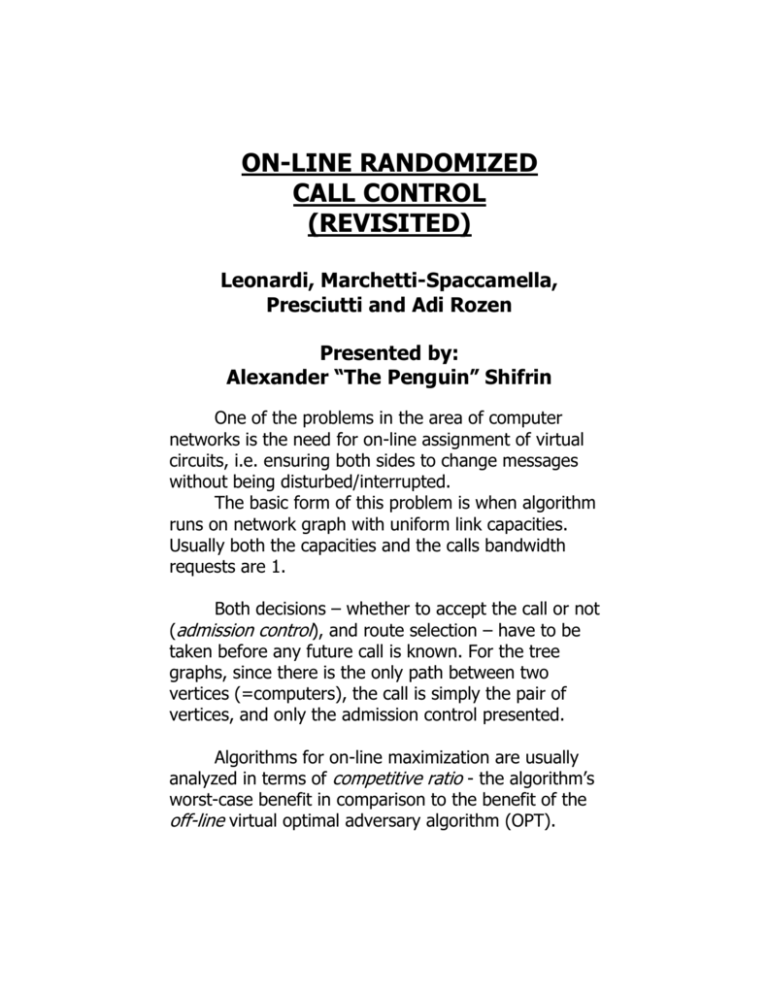
ON-LINE RANDOMIZED CALL CONTROL (REVISITED) Leonardi, Marchetti-Spaccamella, Presciutti and Adi Rozen Presented by: Alexander “The Penguin” Shifrin One of the problems in the area of computer networks is the need for on-line assignment of virtual circuits, i.e. ensuring both sides to change messages without being disturbed/interrupted. The basic form of this problem is when algorithm runs on network graph with uniform link capacities. Usually both the capacities and the calls bandwidth requests are 1. Both decisions – whether to accept the call or not (admission control), and route selection – have to be taken before any future call is known. For the tree graphs, since there is the only path between two vertices (=computers), the call is simply the pair of vertices, and only the admission control presented. Algorithms for on-line maximization are usually analyzed in terms of competitive ratio - the algorithm’s worst-case benefit in comparison to the benefit of the off-line virtual optimal adversary algorithm (OPT). Two main categories of algorithms are used for the purpose. In the previous article the deterministic algorithm developed by Awerbuch, Azar and Plotkin (AAP) was presented. AAP works for any topology of the network, and achieves the asymptotically best competitive ratio – - log(n), when n is a number of vertices in the network. But it limits the bandwidth of each call to be a little part of link capacities. Without the limit they proved a lower bound of (n) for deterministic algorithms. Another category is the randomized algorithms, said to be c-competitive if for any sequence of calls it is expected to accept at least 1/c of number of calls that the OPT can accept. Again, logarithmic coefficients for certain topologies achieved. But all these algorithms haven’t been analyzed with respect to their probability to get a good solution. It may happen that, with high probability, a very poor benefit is achieved, so they are not giving an appropriate solution for the problem. This means that the new approach is needed. The Question: Can a randomized algorithm with optimal (up to a constant factor) competitive ratio guarantee a constant fraction of expected benefit with constant probability? Trying to answer (for tree networks): There is a family of randomized algorithms with competitive ratios of 2klog2D (where k is constant 12 and D is the longest path in the tree) and the probability to get any constant fraction of the expected benefit that tends to a constant as OPT/logD tends to infinity. This probability can be for any 1- fraction made as close to 1 as wanted at the expense of competitive ratio (larger k). The presented family of algorithms based on a complex approach: First, the deterministic filter is applied, And a call that passed it is presented to a randomized selection procedure. The various algorithms of the family are distinguished by the randomized selection used. The basic procedure is very simple and consists of two steps: With probability 1-p a call is rejected and with probability p is considered, And, finally, accepted if it doesn’t intersect any previous considered call. The set of the calls that passed the filter has two important properties: 1) Its cardinality is a constant fraction of the OPT ( OPT/6) 2) The number of intersections between the calls of the set is at most |set|log2D Notations: A - the algorithm described above and the set of the calls it accepted; L - the set of candidate call, i.e. calls that passed the filter E - the expected benefit of A Pr = probability Theorem: A is 6/p(1-plog2D) – competitive algorithm, and, for any (0,1], Pr(A<(1-)E) exp ( -(OPTp/48)((1-plog2D))2) + + 1/(1+½(1/plog2D-1)) Corollaries: 1) For any k12, Ap with p=6/klog2D is 2klog2D - competitive. P=1-Pr(Ap<(1-)E) as OPT/logD tends to infinity, P tends to 1-1/(1+½(k/6-1)). 2) The algorithm B, that with probability ½ accepts first calls and stops, and with probability ½ runs A, with constant probability obtains the benefit which is the constant fraction of the expectation (=O(logD)): if OPT=O(logD), then with probability ½ B has benefit 1= O(OPT/O(logD)), else with probability ½ B runs A, which is that case achieves OPT/O(logD) with constant probability (according to previous corollary). Proof of the theorem: The first part: We prove that the expected number of calls accepted by A is at least Lp(1-plog2D). The filter ensures us that L OPT/6, and the competitive ratio follows. The candidate calls are numbered from 1 to L by the order of arrival. If calls i and j intersect it is denoted by ij. We need some indicator random variables: ci = 1 <=> the i’th candidate is considered (C = ci) yi,j = 1 <=> both i and j considered (i<j, ij) rj = 1 <=> there is i such that yi,j=1 (Y = yi,j R = rj) A candidate is accepted if considered, but none of its previous intersecting candidates was considered. If j considered but not accepted, then there is i<j, ij, that was considered cj=1, rj=1. This means that A=C- R C-Y E E[C]-E[Y]. Clearly, E[C]=Lp, Pr(yi,j=1)=p2. By the property of the filter, there are at most Llog2D pairs i<j such that ij E[Y] Llog2D p2 E E[C]-E[Y] L(p-log2D p2) = = Lp(1-plog2D). The second part: For (0,1], since E[C] E[Y]/plog2D E[R]/plog2D, we have: Pr(A<(1-)E) = Pr((C-R)< (1-)E[C-R]) Pr(C<E[C]-½E[C-R]) + Pr(R>E[R]+½E[C-R]) Pr(C<E[C]-½(1-plog2D)E[C]) + + Pr(R>E[R]+½(1/plog2D-1)E[R]) = = Pr(C<(1-½(1-plog2D))E[C]) + + Pr(R>(1+½(1/plog2D-1))E[R]). C is the sum of L random variables set to 1 with equal probability p and to 0 with equal probability 1-p. We use the following version of Chernoff’s bound: let μ=E[C]=pL for every γ(0,1], Pr(C<(1-γ)μ) < e-μγ/2. R is the sum of dependent random variables, as for all pairs i, j, i<j, yi,j depends on the random choice for candidate i. We use the Markov inequality for the second summand. Using E[C] OPTp/6, we have: Pr(A<(1-)E) < < exp(-½E[C](½(1-plog2D))2) + + 1/(1+½(1/plog2D))) = = exp(-½Lp(½(1-plog2D))2) + + 1/(1+½(1/plog2D))) exp(-(OPTp/12)(½(1-plog2D))2) + + 1/(1+½(1/plog2D))). Appendix: an alternative filter. This filter uses AAP algorithm, originally designed for general networks of high capacity. The test runs the AAP on the tree, assuming link capacities of log4D. In such a case, the set of the calls, accepted by AAP, is OPT/5, when the OPT works with capacities of 1. Since the capacity of each link is bounded (log4D), the number of intersections in L (= AAP) is at most L2log2D. The results stated for A are similar, with necessary modifications in the constants.


